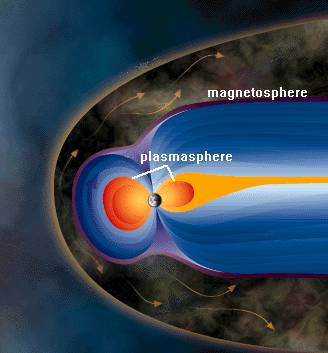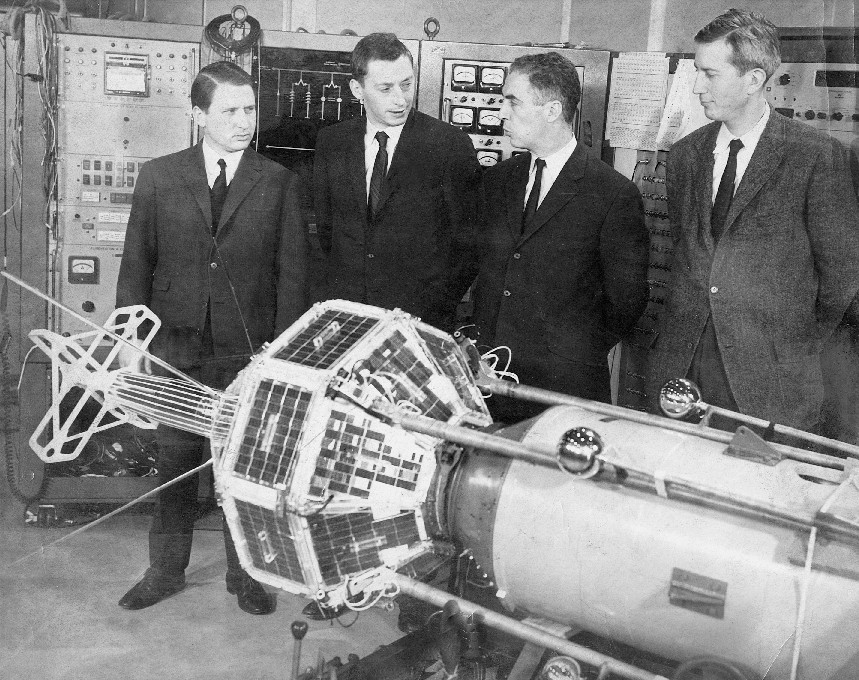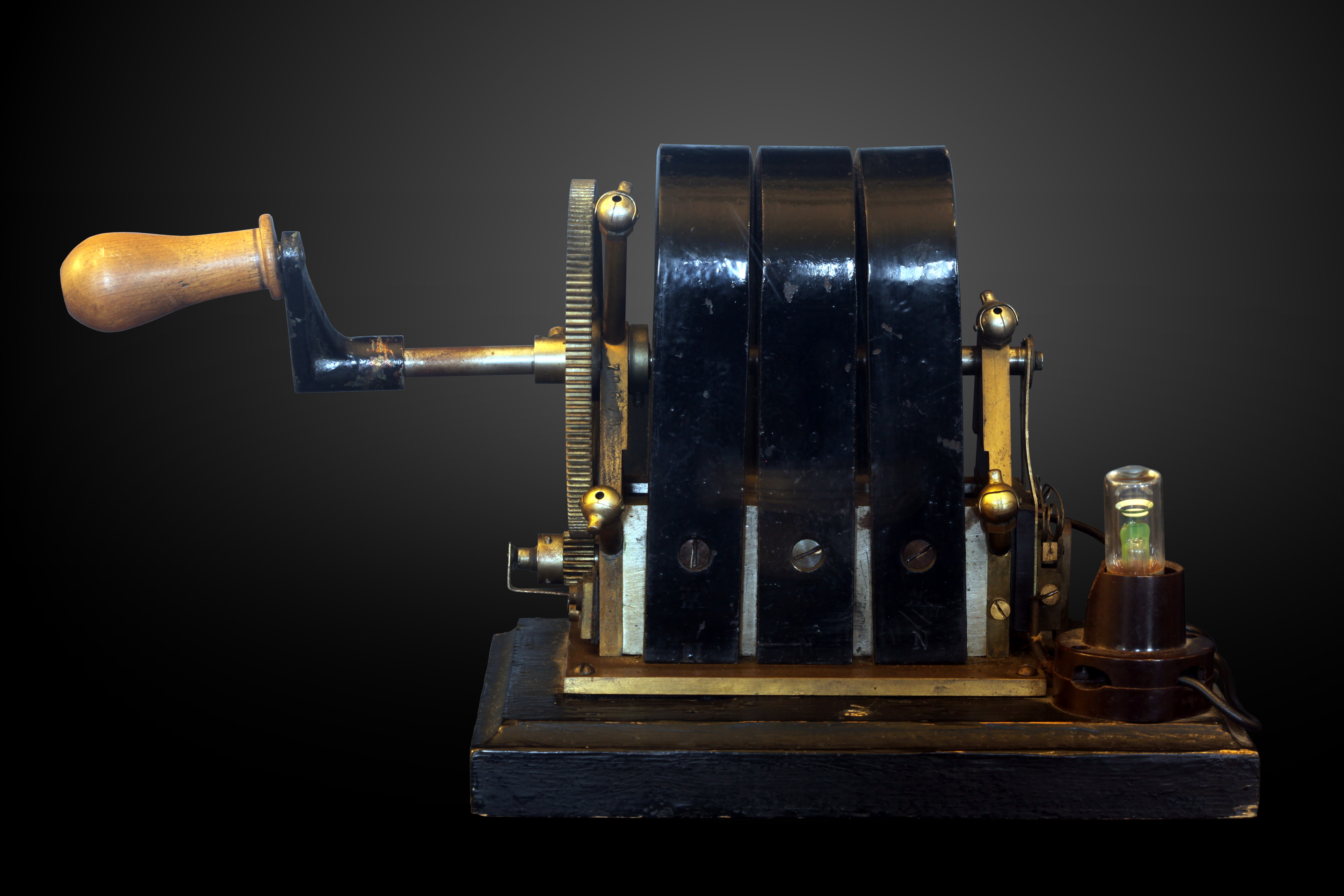|
Plasmasphere
The plasmasphere, or inner magnetosphere, is a region of the Earth's magnetosphere consisting of low-energy (cool) plasma. It is located above the ionosphere. The outer boundary of the plasmasphere is known as the plasmapause, which is defined by an order of magnitude drop in plasma density. In 1963 American scientist Don Carpenter and Soviet astronomer proved the plasmasphere and plasmapause's existence from the analysis of very low frequency (VLF) whistler wave data. Traditionally, the plasmasphere has been regarded as a well behaved cold plasma with particle motion dominated entirely by the geomagnetic field and, hence, co-rotating with the Earth. History The discovery of the plasmasphere grew out of the scientific study of whistlers, natural phenomena caused by very low frequency (VLF) radio waves. Whistlers were first heard by radio operators in the 1890s. British scientist Llewelyn Robert Owen Storey had shown lightning generated whistlers in his 1953 PhD dissertatio ... [...More Info...] [...Related Items...] OR: [Wikipedia] [Google] [Baidu] |
IMAGE (spacecraft)
IMAGE (Imager for Magnetopause-to-Aurora Global Exploration, Explorer 78 or MIDEX-1) was a NASA Medium Explorer program, Medium Explorer mission that studied the global response of the Magnetosphere, Earth's magnetosphere to changes in the solar wind. It was believed lost but as of August 2018 might be recoverable. It was launched 25 March 2000, at 20:34:43.929 Coordinated Universal Time, UTC, by a Delta II launch vehicle from Vandenberg Space Force Base, Vandenberg Air Force Base on a two-year mission. Almost six years later, it unexpectedly ceased operations in December 2005 during its extended mission and was declared lost. The spacecraft was part of NASA's Sun-Earth Connections Program, and its data has been used in over 400 research articles published in peer-reviewed journals. It had special cameras that provided various breakthroughs in understanding the dynamics of Plasma (physics), plasma around the Earth. The principal investigator was Jim Burch of the Southwest Res ... [...More Info...] [...Related Items...] OR: [Wikipedia] [Google] [Baidu] |
Llewelyn Robert Owen Storey
Llewelyn Robert Owen Storey (born 5 November 1927; also known as L. R. O. Storey, L. R. Owen Storey, and Owen Storey) is a British physicist and electrical engineer who has worked and lived most of his adult life in France. He is known for his research on the Earth's atmosphere, especially whistlers—very low frequency (VLF) radio waves caused by lightning strikes—and the plasmasphere. He was the first person to prove whistlers are caused by lightning strikes and to deduce the plasmasphere's existence. He was heavily involved in designing scientific instruments for FR-1, a 1965 French-American satellite, and subsequent studies and experiments using data FR-1 collected. Early life Storey was born on 5 November 1927 in Crowborough, England, United Kingdom. He received a Bachelor of Arts degree in natural sciences in 1948 and a PhD in physics in 1953, both from the University of Cambridge. He became interested in whistlers during his time as a graduate student. In fact, Storey in ... [...More Info...] [...Related Items...] OR: [Wikipedia] [Google] [Baidu] |
FR-1 (satellite)
FR-1 was the second French satellite. Planned as the first French satellite, it was launched on 6 December 1965—ten days after the actual first French satellite, '' Astérix''—by an American Scout X-4 rocket from the Western Range at Vandenberg Air Force Base. The scientific satellite studied the composition and structure of the ionosphere, plasmasphere, and magnetosphere by measuring the propagation of very low frequency (VLF) waves and the electron density of plasma in those portions of the Earth's atmosphere. FR-1's VLF receiver operated until 26 August 1968. FR-1 remains in orbit as of 2023. Background FR-1 was the first step of an ambitious French plan to launch six FR-series satellites, each meant to study a different aspect of the Earth's atmosphere. FR-1 was generally designed to study the Earth's magnetic and electric fields in the ionosphere and magnetosphere. The satellite '' Astérix''—ultimately France's first satellite, launched ten days before FR-1—was ... [...More Info...] [...Related Items...] OR: [Wikipedia] [Google] [Baidu] |
Earth's Magnetic Field
Earth's magnetic field, also known as the geomagnetic field, is the magnetic field that extends from structure of Earth, Earth's interior out into space, where it interacts with the solar wind, a stream of charged particles emanating from the Sun. The magnetic field is generated by electric currents due to the motion of convection currents of a mixture of molten iron and nickel in Earth's outer core: these convection currents are caused by heat escaping from the core, a natural process called a geodynamo. The magnitude of Earth's magnetic field at its surface ranges from . As an approximation, it is represented by a field of a magnetic dipole currently tilted at an angle of about 11° with respect to Earth's rotational axis, as if there were an enormous bar magnet placed at that angle through the center of Earth. The North geomagnetic pole (Ellesmere Island, Nunavut, Canada) actually represents the South pole of Earth's magnetic field, and conversely the South geomagnetic ... [...More Info...] [...Related Items...] OR: [Wikipedia] [Google] [Baidu] |
Whistler (radio)
A whistler is a very low frequency (VLF) electromagnetic (radio) wave generated by lightning. Originally published by Stanford University Press, Stanford, California (1965). Frequencies of terrestrial whistlers are 1 kHz to 30 kHz, with maximum frequencies usually at 3 kHz to 5 kHz. Although they are electromagnetic waves, they occur at audio frequencies, and can be converted to audio using a suitable receiver. They are produced by lightning strikes (mostly intracloud and return-path) where the impulse travels along the Earth's magnetic field lines from one hemisphere to the other. They undergo dispersion of several kHz due to the slower velocity of the lower frequencies through the plasma environments of the ionosphere and magnetosphere. Thus they are perceived as a descending tone which can last for a few seconds. The study of whistlers categorizes them into Pure Note, Diffuse, 2-Hop, and Echo Train types. Voyager 1 and 2 spacecraft detected whistle ... [...More Info...] [...Related Items...] OR: [Wikipedia] [Google] [Baidu] |
Ionosphere
The ionosphere () is the ionized part of the upper atmosphere of Earth, from about to above sea level, a region that includes the thermosphere and parts of the mesosphere and exosphere. The ionosphere is ionized by solar radiation. It plays an important role in atmospheric electricity and forms the inner edge of the magnetosphere. It has practical importance because, among other functions, it influences radio propagation to distant places on Earth. Travel through this layer also impacts GPS signals, resulting in effects such as deflection in their path and delay in the arrival of the signal. History of discovery As early as 1839, the German mathematician and physicist Carl Friedrich Gauss postulated that an electrically conducting region of the atmosphere could account for observed variations of Earth's magnetic field. Sixty years later, Guglielmo Marconi received the first trans-Atlantic radio signal on December 12, 1901, in St. John's, Newfoundland (now in Canada) usin ... [...More Info...] [...Related Items...] OR: [Wikipedia] [Google] [Baidu] |
Van Allen Probes
The Van Allen Probes, formerly known as the Radiation Belt Storm Probes (RBSP), were two robotic spacecraft that were used to study the Van Allen radiation belts that surround Earth. NASA conducted the Van Allen Probes mission as part of the Living With a Star program. Understanding the radiation belt environment and its variability has practical applications in the areas of spacecraft operations, spacecraft system design, mission planning and astronaut safety. The probes were launched on 30 August 2012 and operated for seven years. Both spacecraft were deactivated in 2019 when they ran out of fuel. They are expected to deorbit during the 2030s. Overview NASA's Goddard Space Flight Center manages the overall Living With a Star program of which RBSP is a project, along with Solar Dynamics Observatory (SDO). The Johns Hopkins University Applied Physics Laboratory (APL) was responsible for the overall implementation and instrument management for RBSP. The primary mission was schedul ... [...More Info...] [...Related Items...] OR: [Wikipedia] [Google] [Baidu] |
OV3-3
Orbiting Vehicle 3-3 (also known as OV3-3), launched 4 August 1966, was the third satellite to be launched in the OV3 series of the United States Air Force's Orbiting Vehicle program. The satellite measured charged particles in orbit so that their danger to space-based payloads could be assessed. OV3-3 is still in orbit as of 29 July 2021. History The Orbiting Vehicle satellite program arose from a US Air Force initiative, begun in the early 1960s, to reduce the expense of space research. Through this initiative, satellites would be standardized to improve reliability and cost-efficiency, and where possible, they would fly on test vehicles or be piggybacked with other satellites. In 1961, the Air Force Office of Aerospace Research (OAR) created the Aerospace Research Support Program (ARSP) to request satellite research proposals and choose mission experiments. The USAF Space and Missiles Organization created their own analog of the ARSP called the Space Experiments Support Program ... [...More Info...] [...Related Items...] OR: [Wikipedia] [Google] [Baidu] |
Satellite
A satellite or an artificial satellite is an object, typically a spacecraft, placed into orbit around a celestial body. They have a variety of uses, including communication relay, weather forecasting, navigation ( GPS), broadcasting, scientific research, and Earth observation. Additional military uses are reconnaissance, early warning, signals intelligence and, potentially, weapon delivery. Other satellites include the final rocket stages that place satellites in orbit and formerly useful satellites that later become defunct. Except for passive satellites, most satellites have an electricity generation system for equipment on board, such as solar panels or radioisotope thermoelectric generators (RTGs). Most satellites also have a method of communication to ground stations, called transponders. Many satellites use a standardized bus to save cost and work, the most popular of which are small CubeSats. Similar satellites can work together as groups, forming constellatio ... [...More Info...] [...Related Items...] OR: [Wikipedia] [Google] [Baidu] |
THEMIS
In Greek mythology and religion, Themis (; ) is the goddess and personification of justice, divine order, law, and custom. She is one of the twelve Titan children of Gaia and Uranus, and the second wife of Zeus. She is associated with oracles and prophecies, including the Oracle of Delphi. Name ''Themis'' means "divine law" rather than human ordinance, literally "that which is put in place", from the Greek verb ''títhēmi'' ( τίθημι), meaning "to put." To the ancient Greeks she was originally the organizer of the "communal affairs of humans, particularly assemblies." Moses Finley remarked of ''themis'', as the word was used by Homer in the 8th century BCE, to evoke the social order of the 10th- and 9th-century Greek Dark Ages: Finley adds, "There was ''themis''—custom, tradition, folk-ways, ''mores'', whatever we may call it, the enormous power of 'it is (or is not) done'." In the ''Hymn to Apollo'', Themis is referred to as " Ichnaea", meaning "Tracker". Descr ... [...More Info...] [...Related Items...] OR: [Wikipedia] [Google] [Baidu] |
Magneto Plasma Sphere
A magneto is an electrical generator that uses permanent magnets to produce periodic pulses of alternating current. Unlike a dynamo, a magneto does not contain a commutator to produce direct current. It is categorized as a form of alternator, although it is usually considered distinct from most other alternators, which use field coils rather than permanent magnets. Hand-cranked magneto generators were used to provide ringing current in telephone systems. Magnetos were also adapted to produce pulses of high voltage in the ignition systems of some gasoline-powered internal combustion engines to provide power to the spark plugs. Use of such ignition magnetos for ignition is now limited mainly to engines without a low-voltage electrical system, such as lawnmowers and chainsaws, and to aircraft engines, in which keeping the ignition independent of the rest of the electrical system ensures that the engine continues running in the event of alternator or battery failure. For redundancy ... [...More Info...] [...Related Items...] OR: [Wikipedia] [Google] [Baidu] |










